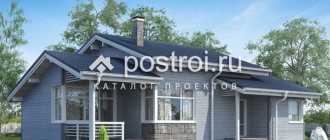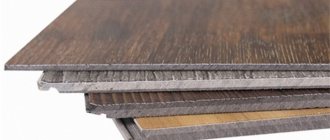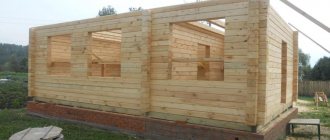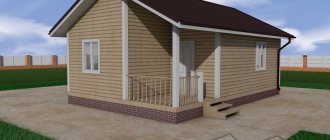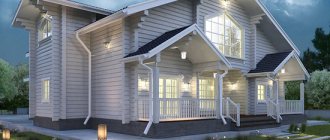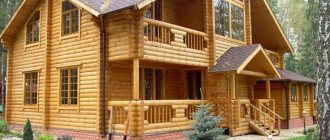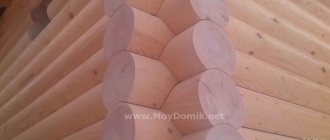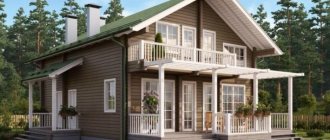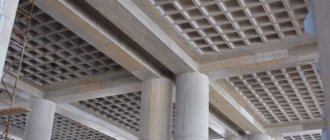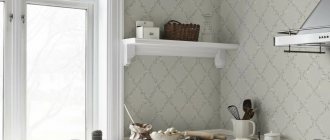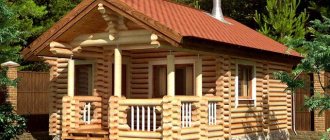Hello, dear friends!
Having your own country house or dacha, remote from active civilization, is the dream of many. Moreover, this dream does not look like a rickety shack with cracks in the walls and a leaky roof. No, people see a full-fledged house, neat, interesting on the outside and fully comfortable on the inside. For those who have such dreams and who see their future masterpiece made of timber, our conversation for today is profiled timber: the pros and cons of this natural material.
In Russia, for the most part, construction timber is made from softwood. Most often pine trees grow in the northern regions. This is justified, since natural pine resin reduces rotting and gives strength to the material. And the northern climate reduces the percentage of natural wood moisture. Only the whole (heart) part of the tree is used.
What is profiled timber?
Glued profiled timber
This modern lumber is made using industrial equipment. During production, it is subjected to several types of processing, resulting in the wood acquiring its final shape and unique characteristics.
The production of profiled timber is mainly carried out from the following types of wood:
- pine;
- spruce;
- cedar;
- aspen;
- larch.
In private housing construction, pine is usually used, as it is cheaper. Baths made of profiled timber are often built from cedar or aspen. Both breeds tolerate temperature fluctuations and high humidity well. Larch has a long service life, but is expensive.
Spruce is considered the least preferable. It is susceptible to rotting, but has a beautiful appearance, so it is used mainly for internal partitions and decoration.
An important feature of profiled timber is the presence of a profile, which is located on both sides. This element provides good fixation and reduces the number of blown zones in the wall. In addition, the profile speeds up the construction of the building and allows you to save on insulation.
Production is carried out in accordance with GOSTs (8486-86, 8242-88, 24454-80, 11047-90). State standards establish technical requirements for lumber intended for construction.
Profiled timber production
It happens in several stages:
- Selection of wood. This stage determines the future characteristics of the product.
- Selection of section. The market offers square, rectangular and rounded sides.
- Rejection. Lumber with defects is removed.
- Calibration The remaining ones are grouped depending on size.
- Drying - natural or chamber. Natural drying takes several months, chamber drying - 2-4 weeks.
- Some manufacturers at this stage saw the material so that it does not crack, and treat it with antiseptics and fire retardants.
- The lumber is then planed and profiled.
Application
Profile timber in a building is always beautiful, economical and warm. That is why it has received a wide range of applications. It is used in the construction of buildings with different architectural styles. And the use of high-quality production technology allows you to build a comfortable and cozy home in a short time.
Most often it is used in the construction of residential and country houses, baths, and functional buildings: tourist and residential complexes. Modern installation technology provides high strength to all structures. Therefore, increasingly in areas with increased seismic activity, profiled timber has become the main building material.
Pros and cons of profiled timber
Main advantages
Profiled timber has many advantages compared to other materials:
- attractive appearance (houses made from it do not require additional finishing);
- ecologically pure;
- low thermal conductivity, allows you to reduce the cost of heating your home;
- there is no need to seal the walls, since the crowns fit tightly to each other;
- high strength;
- treated with agents against fungi, mold and fire;
- maintains original dimensions;
- ease of assembly;
- quick installation;
- long service life;
- does not crack;
- after assembling a log house from dried profiled timber, slight shrinkage of the house occurs;
- the house is lighter than other materials, so it does not require a massive foundation. Can be installed on a columnar or strip foundation.
Profiled timber - disadvantages
Profiled timber has several disadvantages:
- Frequent manufacturing defects.
- Profile defects are often encountered.
- It is not always sufficiently dried, as a result of which the shrinkage period increases.
- High flammability. Requires compliance with fire safety standards and requires special treatment.
- The need for additional insulation. It occurs when the thickness does not correspond to climatic conditions or the construction technology is not followed.
- Wood darkens over time.
- After construction is completed, it is difficult to change the layout of the premises.
Nuances of technology
The construction of suburban housing using mini-timber technology has its own characteristics:
- Pouring the foundation . The finished house does not create a significant load on the ground due to the small mass of the wall structures. This makes it possible to use a lightweight foundation. Usually a shallow strip base is sufficient; Tile, screw and pile foundations are also suitable.
- Wall installation . Two timbers are installed in a row at the same time; they form a double wall, which, after filling the gap with heat-insulating material, becomes a reliable wall structure with the specified characteristics.
- Choice of insulation . For wooden structures, a thermal insulation material is selected that does not restrict air circulation. It is allowed to use foam glass, vermiculite (as a mixture filler), polystyrene foam balls, flax and mineral wool. Manufacturers recommend thermally insulating a house from double timber with ecowool, which does not allow dew point (condensation) to form inside the walls.
Blowing ecowool Source authentics.pw
Types of profiled timber
Classification is carried out according to the following characteristics:
- front side view;
- dimensions;
- profile type;
- type of drying;
- structure.
Front side view
She may be:
- Straightforward. The most popular is timber with straight sides. This form is convenient for subsequent wall finishing; it is the cheapest.
Straight profiled timber
2. D-shaped. The outer side has a curved shape, like a rounded log, while the inner side is straight. A house made of such lumber does not require additional external finishing.
"D" shaped profiled timber
3. O-shaped. The most expensive type. With this profile, you don’t have to do any cladding either inside or outside the house.
O-shaped glued profiled timber
Profiled timber - dimensions
Typically, the thickness of timber for external walls is from 100 to 200 mm.
The most common sizes (mm): 100x100, 150x150 and 150x200.
For houses built according to individual projects, manufacturers produce products with dimensions that correspond to the features of a particular structure.
The area of use depends on the thickness of the material. 100 mm timber is used for light buildings (gazebos, cottages) or internal partitions. A thickness of 150 mm is suitable for residential buildings, and 200 mm is used for the construction of expensive cottages.
Profile type
Profiled timber is available with the following types of profiles:
- Single-spike. The presence of one ridge eliminates the possibility of water accumulation at the joint. Characteristic for naturally drying materials.
- Double (two-spike). This type provides a more secure hold. Thanks to two spikes, thermal insulation is increased.
- Multiple (comb). This type has from 3 to 8 spines. Compared to other types, the comb provides the most reliable fastening and maximum thermal insulation.
- Beveled chamfers. This type is one of the varieties of double profiles. Due to the beveled chamfers, less water accumulates at the attachment point, making caulking of the walls easier.
- Finnish (Scandinavian) type, which has two ridges with beveled chamfers, located at a large distance from each other.
Type of profile of profiled timber
In this case, profiled timber can be either glued or regular.
Timber drying type
Materials highlighted:
- natural drying;
- chamber-drying profiled timber.
Moisture content determines the performance characteristics of the material.
The first type of timber is dried naturally. Lumber is laid in a place protected from water and sun so that air circulates between them. To achieve the desired level of humidity, the products are aged for several months. The disadvantage of this method is long drying and shrinkage.
When chamber drying, the workpieces are placed in special chambers - ovens, which reduces production time. This material is more expensive, but shrinkage occurs quickly and is very small.
After drying is complete, the wood retains a certain amount of moisture. Material that has undergone natural drying has a moisture content from 22% to 40%. When chamber drying - 18-20%.
Profiled timber: price
To make profiled timber, much more time and skill is required. You also need special professional equipment and the ability to handle it.
It is logical that such material is noticeably more expensive than simple smooth material, even if it is processed. But the profile significantly simplifies construction. The walls fold up like a construction set, saving labor and time. Less insulation required.
Dry profiled solid timber is usually 30% cheaper than laminated timber. This is due to the peculiarities of the technologies used to create products. In the case of laminated veneer lumber, the buyer is freed from the need to additionally sand the facade before starting painting. This allows you to save on costs.
The cost of finished houses is approximately the same for both types of materials. Therefore, the choice is made precisely on the basis of operational characteristics.
When purchasing, it is important not to skimp on really high-quality wood, harvested according to all the rules. There are cases when an unscrupulous manufacturer neglects technology in order to save money. It is better to purchase profiled timber from a well-established manufacturer.
Chamber drying log houses
To reduce the drying time of wood, chamber drying is used. With this method, drying is carried out under the influence of air, steam or a mixture of flue gas and air, heated to 100 C for 20 days.
Chamber drying is used for:
- maximum reduction of wood moisture content;
- to disinfect it from fungal spores and larvae of harmful insects, and also increases its biological stability;
- to increase service life.
Based on opinions and reviews about chamber-drying log houses, a number of advantages can be identified:
- gives minimal shrinkage (3%). This is quite enough to ensure that the structure does not become deformed during operation.
- Timber with increased knotiness is immediately rejected during chamber drying.
- Construction takes place in the shortest possible time (1-2 months) and it is possible to erect a roof and carry out interior decoration immediately after installing the log house.
- The formation of cracks is reduced to a minimum.
- Has minimal thermal conductivity.
- Its dimensions allow it to be used in buildings of varying complexity.
Only wood can create a healthy and favorable microclimate inside the house. Its cost and high quality indicators, the natural beauty of wood, and environmental friendliness will satisfy any developer.
Structure of the timber material
Depending on the design features, lumber is divided into two types:
- from the array;
Solid planed timber
Such a beam is made by simply removing the cylindrical part from four sides. Rough boards with a semicircular convexity on one side come out of the scraps - slabs. The result is a material with a cross-section of a regular quadrangular shape.
Typically, it is not additionally sanded or dried before being sold. Therefore, it has a low cost.
Sometimes solid timber is planed or sanded, adding beauty.
Solid timber is usually made from softwood. It is environmentally friendly and requires less production time and costs. It has a lower price.
- laminated veneer lumber;
Glued beam
Glued laminated timber is a high quality lumber. It is assembled from thin wooden slats, which are pre-dried to the required humidity, eliminating knots and any possible defects. This technology eliminates the possibility of deformation during shrinkage and reduces the amount of waste during construction. To achieve the required properties, craftsmen glue lamellas from different types of wood. Glued laminated timber consists of several dried and processed lamellas glued together. It is characterized by increased resistance to rotting and burning, as well as a higher price.
Glued laminated timber has interesting differences. Both types mentioned above are suitable for its manufacture. In this case, the tree undergoes serious processing. Using special equipment along the entire length, a tenon is machined on one side and a groove on the other. During construction, they are connected and form a thermal lock. It does not eliminate the need to insulate the joints, but significantly reduces heat loss.
Naturally dried log houses
Any type of wood has its own moisture content. In a naturally dried log house, it has a high rate. It will take a long time for the log house to dry naturally. After assembly, the house must stand for at least a year to complete the process of shrinking and drying, and this is a long time. It is not recommended to immediately finish the house and install a roof. The roof and floor are laid rough, and the house itself continues to dry and settle for another year.
The use of natural drying logs has a number of disadvantages:
- A large percentage of shrinkage: the higher the initial moisture coefficient, the more the frame will be subject to deformation.
- High tendency to crack formation.
- There may be distortions in window and door openings.
- It is necessary to additionally treat the timber (especially the ends) with an antiseptic solution.
Those developers who used natural-drying timber when building a house highlight some of its positive aspects:
- in terms of a number of technological indicators and operation, it is not inferior to dried material;
- installation of the log house is easy;
- low cost.
You can build a structure from naturally drying timber when you want to significantly reduce the cost of purchasing building materials. In this case, the time to build a house will increase. But if you plan to slowly and stage-by-stage implement the construction project, then the use of this type of log house will be a completely rational solution.
Another way to save money would be to purchase winter-harvested material for the log house. It has a humidity of only 18%, and this figure is close to the humidity of kiln-drying timber.
Production of solid profiled timber
A typical workpiece is prepared as follows:
- They take a log of wood and process it using special machines.
- The result is a product with a rectangular or round cross-section.
- Special grooves with tenons are cut out on the technical sides. This allows you to create a locking connection for further construction.
When producing profiled timber, they try to preserve as much as possible the natural pattern on the surface characteristic of natural wood. The main material is the core part of the tree trunk, so you don’t have to worry about the strength of the finished product.
Construction from profiled timber
When building walls from smooth timber, quite a lot of time is spent fastening the crowns together. For this purpose, dowels are used - special wooden nails. They are driven into holes pre-drilled every 1.5-2 m, and the next row is planted on top.
Cutting out the bowl for the corner joints is also a labor-intensive task. It is better to perform this delicate work using high-precision equipment. This is what they sometimes do when making profiled timber. And the tenon and groove successfully replace dowels in fastening the crowns and create a windproof seam.
Appearance
Untreated wood looks untidy. The situation is aggravated by tow fibers protruding from the wall. If a house is built from simple timber, usually only the part that will be facing inward is processed. Or use lumber for decorative finishing:
- lining;
- eurolining;
- imitation timber;
- siding;
- block house.
Work of qualified specialists
In order not to be upset with the result later, it is recommended to abandon independent construction, the work should be left in the hands of professionals, and hire a team of builders. The cost of their work will not be as high as if you damage the material during improper construction and you have to buy everything again. What the contractor usually offers:
Professional selection of foundations for your project. There is no point in arguing that another type suits many owners and will cost much less than the recommended one. A decent builder will never undertake the construction of an initially doomed house. Surveyors have an excellent understanding of the characteristics of the soil, so they select the foundation not because of their whim, but according to generally accepted factors.
Glued laminated timber
Sometimes a person who wants to build his house from profiled timber is faced with a choice: which timber is optimal for construction?
How laminated veneer lumber is produced
Glued laminated timber
To produce laminated veneer lumber, a more complex method is used. The following several stages are expected:
- The logs are sawn into boards, which are then dried using special chambers.
- Before and after the drying process, sorting must be carried out.
- Gluing the boards to the desired size is done after drying.
- Aging under pressure and profiling are the last stages of processing.
- After this, the product is released onto the market, ready for further use.
Strength
When a profiled solid beam is produced, the outer part of the wood is cut off from the log. And it is usually stronger compared to the internal one. Therefore, laminated laminated timber is superior in this parameter to profiled solid timber.
Pressing, gluing and drying are the main steps in creating laminated veneer lumber. Additional processing is carried out to provide reliable protection from any influences. That is why the glued variety of material is more resistant to damage of various types.
Humidity and shrinkage of profiled timber
Glued laminated timber initially has low humidity levels, up to 11-14%. Therefore, shrinkage produces a result of only 1%. The drying rate of the main structure in this case will be almost zero.
Uniform humidity within 20-22% is typical for profiled solid timber. Such results can be achieved through the use of modern drying technologies.
Environmental friendliness
Profiled solid timber does not have any additional elements in its composition. It is coated with special compounds. But the material remains absolutely safe both for the buildings themselves and for those who are constantly inside.
When connecting laminated timber elements, additional components are used, which can be divided into three groups:
- Safe.
- Potentially dangerous.
- Generally unsuitable for residential premises.
The main indicator is the amount of formaldehyde used in the production process. If its level does not exceed 0.5 mg/liter, the material is considered safe and suitable for use.
Glued laminated timber may become deformed if low quality compounds were used during gluing. The glue itself costs differently, depending on the initial characteristics of a given component.
Fire and biological resistance
Any type of massive timber is vulnerable to environmental impacts. After all, before building a house from timber, special compounds are used to treat the material antiseptically. Over time, they are washed out and weathered, which is why resistance to such types of damage decreases.
Fire safety also remains low for all types of structures.
G4 is a standard marking that is used for products. It persists even after additional processing. In the case of laminated timber, the safety indicator is average. The material is quite dense, which is achieved through pressing. But it is still not possible to completely get rid of flammability.
Aesthetic component
Glued laminated timber has a perfectly flat surface that does not require further cladding. There are also no holes from old knots on the material, which only improves the appearance.
But when using profiled solid timber, such ideal smoothness cannot be achieved. There may be various holes from old knots and cracks.
